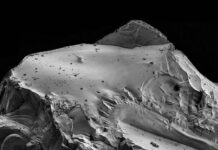Recent laboratory experiments have revealed a surprising possibility: some planets might generate their own water, rather than acquiring it from external sources like comets or asteroids. This discovery significantly alters our understanding of how water-rich exoplanets form and raises new questions about the potential for life beyond Earth.
Simulating Extreme Planetary Conditions
Researchers successfully simulated the extreme conditions found within certain exoplanets by subjecting olivine — a common mineral in planetary interiors — to high-energy laser beams in the presence of hydrogen gas. This process effectively strips the mineral of its oxygen atoms, enabling the oxygen to react with the hydrogen and subsequently produce water. The team published their findings October 29 in Nature.
Water-Rich Exoplanets: A Long-Standing Mystery
The existence of numerous exoplanets, ranging in size and mass between Earth and Neptune, has puzzled scientists. Many of these planets orbit remarkably close to their host stars, far closer than Earth orbits the Sun. Their densities indicate they possess rocky interiors and a substantial layer of water or hydrogen. However, how these planets could accumulate so much water has remained unclear.
The Snow Line and Traditional Theories
Our solar system provides a clear example of the “snow line,” a boundary beyond which water is abundant due to cooler temperatures. Inside the snow line, as seen on Venus, water tends to vaporize. Planets beyond the snow line, such as Saturn and Neptune, are rich in both water and gas. Astrophysicists initially believed that watery exoplanets had to form far from their stars and then migrate inward. However, the new research suggests that water can be produced locally under the right conditions through chemical reactions.
Recreating Extreme Environments: A Diamond Challenge
Replicating these extreme conditions proved challenging. Scientists employed a “diamond anvil cell”— a tiny container — to reach the required temperature and pressure. However, heated hydrogen molecules infiltrated the diamond’s structure, causing it to shatter. To overcome this hurdle, researchers switched to using pulsed lasers, heating the sample for very short periods.
“I still broke a lot of diamonds,” admits Harrison Horn, a planetary scientist at Lawrence Livermore National Laboratory.
Unexpected Water Abundance
When the experiment was successful, the scientists were surprised by the sheer quantity of water produced. “There was no rock left. All I had was metal and water,” Horn said. Geophysicist Dan Shim of Arizona State University added, “We are talking about a lot of water, like thousands of times more water than expected for the Earth if you have a thick layer of hydrogen atmosphere.” Remarkably, about 18 percent of the initial mass was transformed into water.
The Boundary Zone: Where Water Forms
The researchers believe this water-generating process occurs at the boundary between a planet’s rocky interior and its hydrogen-rich atmosphere, where high pressures and temperatures can drive the reaction. The resultant worlds could be either vast ocean worlds, two to five times the size of Earth and covered in deep liquid oceans, or “hycean” worlds— those with a vast ocean covered by a thick hydrogen layer.
A Continuum of Worlds
The findings suggest these types of worlds represent points on a continuum rather than distinct categories. “They are related, like cousins,” explained Shim. Whether a planet becomes an ocean world or a hycean world likely depends on factors like proximity to its star, size, and initial composition.
Implications for Habitability
The study supports the ongoing debate about the habitability of hycean worlds. While recent research suggested much of their water might be trapped in their mantles, leaving the surface dry, this new study increases the likelihood of abundant surface water. “It’s maybe good news for life on those planets,” states Remo Burn, an astrophysicist at the Observatoire de la Côte d’Azur.
Earth’s Ancient Water: A Possible Origin
These findings also provide insights into the origin of Earth’s water. While the extreme conditions required for this reaction don’t exist on Earth today, they might have been present during its formation. An early Earth with a thick hydrogen atmosphere could have facilitated similar water-forming reactions.
Evidence from ancient, deep-earth diamonds— containing tiny water vesicles with a unique chemical signature — supports this hypothesis, suggesting two distinct water reservoirs on Earth: a primitive one formed through early chemical reactions, and a later component delivered by water-rich comets and asteroids.
























